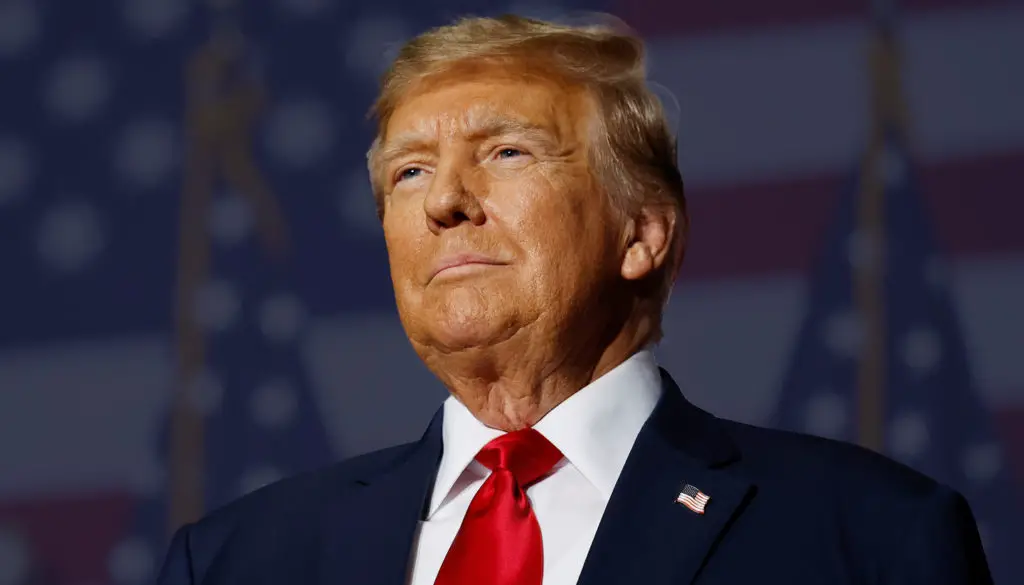The moment passed quickly, almost too fast to notice. As former President Donald Trump raised his hand to gesture during a brief media exchange on the White House lawn ahead of his scheduled visit to Pittsburgh, the sunlight caught something unusual—a faint, discolored patch along the side of his right hand. For just a few seconds, the lens of a C-SPAN camera locked on the area, revealing what appeared to be a fresh bruise.
Trump didn’t acknowledge it. Neither did the reporters gathered. He continued speaking, pivoting from a question about U.S. involvement in Ukraine to a comment about job growth, then pivoted again to trade—his usual machine-gun cadence of controlled deflection. But for viewers online, especially those fluent in social media discourse, the image told its own story. The bruise didn’t go unnoticed.
Theories began to circulate almost immediately. Was it an injury? Was it stress? Had he slipped, punched a wall, or perhaps, as some suggested ironically, just gripped a golf club a little too hard?
The White House was quick to address the chatter, though it did so without fanfare. In a statement released later that afternoon, Press Secretary Karoline Leavitt dismissed any health concerns, attributing the discoloration to “vigorous handshakes, an active lifestyle, and the day-to-day engagement of a president who doesn’t slow down.”
The explanation was almost word-for-word identical to one issued a year earlier when similar marks had been spotted on Trump’s hands following a meeting with French President Emmanuel Macron.
But even if the bruise was minor, the moment seemed to carry an outsized weight. It became a metaphor, as these things often do, especially in an era where politics is consumed as theater and scrutinized like forensic science. A bruise on Trump’s hand? The man who prides himself on strength, endurance, and showmanship? It felt—at least to his opponents—like a chink in the armor.
Yet if Trump had suffered a bruise, politically or physically, he was far from the only one. On the opposite side of the political divide, the Democratic Party was enduring something far more significant than a discoloration: an open wound.
Democratic Approval Falls to Historic Lows
According to a new Quinnipiac University national poll, Democratic lawmakers in Congress have hit a milestone they’d rather avoid—a staggering 53% of their own party’s voters now disapprove of their performance.
Only 41% of Democratic respondents said they were satisfied with how congressional Democrats are handling their responsibilities. Among all registered voters, that approval plummets to just 21%, matching the lowest rating recorded since Quinnipiac began polling the question in 2009.
These are not just bad numbers—they’re historically bad.
In contrast, Republicans are faring slightly better—though not by much. The same survey found 32% of voters approve of congressional Republicans, while over 60% disapprove. Even within their own party, the mood is cooling: while 79% of Republican voters still support their representatives, that number has declined eight points since February. Disapproval has climbed nine points.
So what’s happening?
In the aftermath of the 2024 general election, Democrats were dealt a triple blow: the loss of the presidency, the Senate, and continued erosion in the House. Trump’s return to the White House—barely two years after being indicted in multiple jurisdictions—was a political earthquake. Many in the Democratic Party, especially the progressive base, expected a unified and aggressive response to what they see as an existential crisis for American democracy.
Instead, what they got—at least in the eyes of many voters—was gridlock, half-measures, and hesitancy.
“He’s Everywhere. Where Are They?”
That was the viral question posed by MSNBC host Joy Reid on a recent panel, referring to Trump’s near-daily visibility and rhetorical aggression.
“Donald Trump is on TV. He’s in court. He’s giving interviews. He’s tweeting—or, excuse me, ‘Truthing.’ He’s setting the agenda,” Reid said. “And where are the Democrats? Why aren’t they flooding the airwaves, pounding the table, calling emergency hearings?”
The sentiment is echoed on the ground. In key Democratic strongholds like Michigan, Pennsylvania, and Georgia, voters are expressing confusion and disappointment at what they perceive to be a lack of urgency from the very people they elected to resist Trump’s second term.
In interviews conducted by local news outlets in Philadelphia and Detroit, voters cited everything from a lack of messaging clarity to an absence of charismatic leadership.
“It feels like we’re on the Titanic, and half the crew is arguing about table settings,” said 28-year-old Brandon Wells, a community organizer in Philadelphia. “This isn’t business as usual. The stakes are higher now.”
A Tale of Two Images
It’s difficult to ignore the visual contrast that’s emerged in recent weeks.
On one side: Trump, defiant and omnipresent, a man who courts controversy but never fades. Whether he’s shaking hands, raising fists, or waving from the steps of Air Force One, he knows the power of physical imagery—and he uses it.
On the other side: an aging and increasingly disconnected Democratic establishment, whose public appearances feel sporadic, procedural, and devoid of momentum.
Trump’s bruise may have been a fleeting moment, but it was still a moment—a piece of media that inspired speculation, jokes, concern, and conversation. By contrast, many Democratic leaders haven’t had a moment in months. And in modern politics, attention is everything.
Aging Bodies, Aging Institutions
To understand the full scope of voter discontent, it helps to zoom out even further.
The median age of congressional leadership in both parties now hovers near 70, prompting generational frustration among younger voters who feel alienated from the levers of power.
Trump himself is 79, and his physical health has been the subject of speculation for years. From his weight to his gait to the awkward way he sometimes raises a glass with two hands, everything he does is scrutinized—but crucially, it’s visible. He shows up.
So when Trump raises his bruised hand and waves to a crowd, it can be interpreted a hundred ways—weakness, resilience, even recklessness—but it’s never nothing.
And “never nothing” might be the most potent political strategy of our time.
No Room for Passivity
As one Democratic strategist put it recently in Politico: “You can’t beat something with nothing.”
That “something” is Trump, and the “nothing” is increasingly being associated with the current Democratic messaging vacuum. The party’s internal divisions—between centrists, progressives, and institutionalists—have hamstrung their ability to deliver a coherent alternative.
Frustration is also growing with legacy figures like Senate Majority Leader Chuck Schumer and House Minority Leader Hakeem Jeffries, whom some see as too cautious in a time that demands boldness.
One example: the much-discussed proposal to expand the Supreme Court or impose term limits—popular among younger Democrats—is met with hesitation or silence at the leadership level.
Meanwhile, Trump is already floating names for his 2026 judicial nominees and promising to overhaul entire agencies on day one of his second term.
The Bruise as Symbol
The irony, of course, is that the physical bruise on Trump’s hand—a minor, mundane injury—has arguably generated more engagement than any legislative press conference in weeks.
It’s a reminder of how little things can carry disproportionate weight in political perception. Voters don’t always respond to policy papers and committee reports. They respond to symbols, signs of life, proof of presence.
In 2016, it was “the wall.” In 2020, it was “the virus.” In 2024, it may well be “the bruise.” Or at least, what it represents: the willingness to show up, get dinged, and keep swinging.
Conclusion: Politics in the Age of Performance
As Trump prepares to visit Pittsburgh for an economic summit, his opponents are still struggling to figure out how to fight back—not just against his policies, but against his omnipresence.
Yes, a bruise on a hand may be trivial. But in the void of Democratic momentum, it was a story. It was noticed. It happened in public.
And in politics, especially today, visibility is often mistaken for leadership—and silence, for surrender.
If Democrats hope to recover before the midterms, they’ll need more than statistics and statements. They’ll need their own moments. They’ll need to be present, not just on paper, but on camera, on stage, and on message.
Because as strange as it sounds, one of the most powerful images of the month wasn’t a bill signing or a campaign rally—it was a man’s bruised hand.
And the country noticed.

Adrian Hawthorne is a celebrated author and dedicated archivist who finds inspiration in the hidden stories of the past. Educated at Oxford, he now works at the National Archives, where preserving history fuels his evocative writing. Balancing archival precision with creative storytelling, Adrian founded the Hawthorne Institute of Literary Arts to mentor emerging writers and honor the timeless art of narrative.
